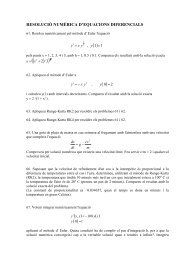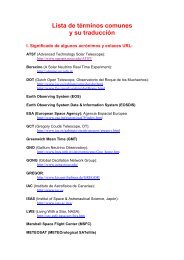Universitat de - Departament d'Astronomia i Meteorologia ...
Universitat de - Departament d'Astronomia i Meteorologia ...
Universitat de - Departament d'Astronomia i Meteorologia ...
You also want an ePaper? Increase the reach of your titles
YUMPU automatically turns print PDFs into web optimized ePapers that Google loves.
10 Chapter 1. Introduction and background<br />
error boxes, single dish and/or poor sensitivity radio observations, etc.), and we do<br />
not know how many non-<strong>de</strong>tections have not been published.<br />
1.2 Microquasars<br />
A microquasar is a radio emitting X-ray binary displaying relativistic radio jets. The<br />
name was given not only because of the observed morphological similarities between<br />
these sources and the distant quasars but also because of physical similarities, since<br />
when the compact object is a black hole, some parameters scale with the mass of<br />
the central object. A schematic illustration comparing some parameters in quasars<br />
and microquasars is shown in Fig. 1.3.<br />
In this context, we can see that the use of Eq. 1.4 leads to temperatures of<br />
∼ 10 7 K in the case of microquasars containing stellar-mass black holes and ∼ 10 5 K<br />
in the case of quasars containing supermassive black holes (10 7 –10 9 M⊙). This<br />
explains why in microquasars the accretion luminosity is radiated in X-rays, while<br />
it is done in the optical/UV domain in the case of quasars.<br />
On the other hand, the characteristic jet sizes seem to be proportional to the<br />
mass of the black hole, since radio jets in microquasars have typical sizes of the<br />
or<strong>de</strong>r of light years, while radio jets in quasars reach distances up to several million<br />
light years in giant radio galaxies.<br />
Last, but not least, the timescales appear to be directly scaled with the mass<br />
of the black hole following τ RS/c = 2GMX/c 3 ∝ M. Therefore, phenomena<br />
that take place in timescales of years in quasars can be studied in minutes in micro-<br />
quasars.<br />
In this sense, one can say that microquasars mimic, on smaller scales, many of<br />
the phenomena seen in AGNs and quasars, but allow a better and faster progress to<br />
un<strong>de</strong>rstand the accretion/ejection processes that take place near compact objects.<br />
The number of currently known microquasars is ∼ 16, among the 43 catalogued<br />
REXBs. It is interesting to note that some authors have proposed that all REXBs<br />
are microquasars, and would be <strong>de</strong>tected as such provi<strong>de</strong>d that there is enough<br />
sensitivity and/or resolution in the radio observations.






